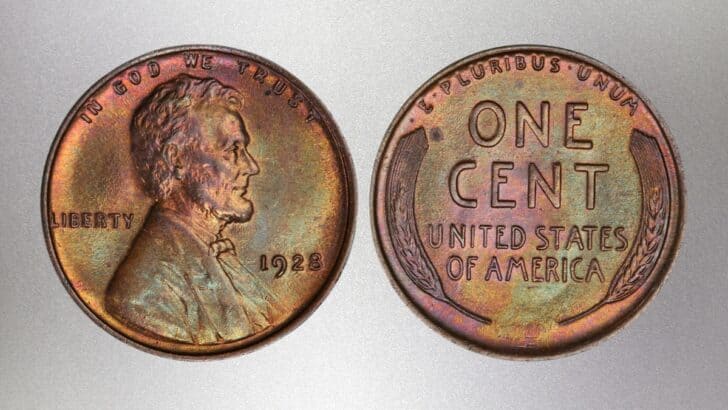The 1928 penny is fantastic in that exquisite condition examples can still be found in old hordes of coins, unopened rolls, and coin collections passed down through generations. Your chance of finding a reasonable condition 1928 Lincoln penny in spare change isn’t great, but it happens!
In 1928, sliced bread was new on the market; Mickey Mouse made his premier as the cartoon character Steamboat Willie, and Amelia Earhart was the first woman to fly a trans-Atlantic flight successfully. In other news, Alexander Fleming discovered the antibiotic he called penicillin. Good stuff.
But what about 1928 pennies? Well, they were indispensable in commerce. After all, cash was king; back then, a dozen eggs were 34 cents, bacon was 27 cents a pound, and a loaf of bread was nine cents. For you drivers, gas was 19 cents a gallon!
Pennies were important in the US economy, and the 1928 penny value was high. The mint addressed what they considered an optimal number of coins in circulation by auditing Federal Reserve Banks and adding a nebulous estimation of independent banks.
In keeping the nation flush with cents, the three US Mints struck an average number of coins based on past production. Philadelphia and Denver minted close to their previous yearly averages, and San Francisco was about eight percent below. Not as small as 1926 numbers (just 4.5 million), but at 17 million, the ’28 “S” coin earns a nice bump in price for high-condition finds.
Surprising Facts about the Lincoln Penny
Many people considered President Abraham Lincoln as iconic, and to commemorate his 100th birthday, the US Treasury issued its first-ever coin with an actual individual’s likeness. That put the production of new US 1-cent coins on track for 1909, when the previous Indian head pennies were replaced with the Lincoln penny.
The Lincoln penny was designed by Victor David Brenner, an engraver living in New York who had previously produced a plaque of Lincoln that President Theodore Roosevelt admired. Brenner immigrated to the US in 1890 and saw America as the land of plenty. He admired our agricultural roots and prosperity, agreeing with “America the Beautiful” lyricist Katharine Lee Bates that our country was forever tied to our “Amber waves of grain.” And, while the obverse of the Lincoln penny bears his likeness, the reverse issued in 1909 had two stalks of the chief grain of the time: wheat.
The 1909 pennies first issued also had Brenner’s initials, VDB, below the wheat stalks. This caused quite a stir at the time among the public, querying about the initials and the “free advertising” it provided, the American Numismatic Association, which was lobbying for new nickel, dime, quarter, and half-dollar designs, and the United States Bureau of the Mint Chief Engraver Charles E. Barber who had designed the “Barber” dimes, quarters, and halves. He disliked the lack of artistry on the Lincoln penny.
Quickly, the Mint stopped production of the “VDB” pennies and removed the artist’s initials. Although many Philadelphia (no mint mark) pennies were produced, the San Francisco Mint only struck 484,000 with the “VDB” reverse. Yes, they command a premium price!
Eight years after the Lincoln Cent was first issued, over two-thirds of all pennies in circulation were still Indian Heads. A year later, in 1918, after Charles E. Barber had passed away, Brenner’s initials returned to the Lincoln cent on the obverse along the bottom of Lincoln’s shoulder.
Although Barber did not consider the Lincoln penny a successful coin, statistics now prove otherwise. Brenner’s design for the Lincoln penny’s obverse is still in use after over a century, making it the longest-running design ever used by the US Mint.
The 100-plus years of production also make it one of the world’s most reproduced pieces of art since it adorns the same pennies made in the billions since 1909.
1928 Lincoln Penny Specifics
The 1928 Lincoln penny follows a standard production run at US Mints.
Obverse Designer: Victor David Brenner
Reverse Designer: Victor David Brenner
Edge: Plain
Diameter: 19.00 millimeters
Weight: 3.11 grams
Composition Metal: 95% Copper, 5% Tin and Zinc
US Mint Production Numbers:
Philadelphia – no mint mark – 134,116,000
Denver – D – 31,170,000
San Francisco – S – 17,266,000
1928 Penny Value
As with all collectibles, coin values are based on mint production numbers, coin availability, and condition. Unlike some years, the 1928 Lincoln penny was produced in reasonable numbers at all three mints. Those made in Philadelphia bore no mint mark and were made in much higher numbers than those from Denver and San Francisco.
Fewer than 5,000 1928 Lincoln pennies in Mint State 60 or higher are likely held in private collections. At higher grades of 66 and above, estimates of surviving coins range in the hundreds.
| 1928 Penny Value Chart | |||
| Type | Grade | ||
| Uncirculated MS64 | Uncirculated MS65 | Uncirculated MS66 | |
| 1928 1C BN | $33.75 | $54.00 | — |
| 1928 1C RB | $47.25 | $122.00 | $195.00 |
| 1928 1C RD | $81.00 | $156.00 | $390.00 |
| 1928-D 1C BN | $115.00 | $260.00 | $780.00 |
| 1928-D 1C RB | $162.00 | $468.00 | $1,090.00 |
| 1928-D 1C RD | $312.00 | $1,250.00 | $8,250.00 |
| 1928-S 1C BN | $188.00 | $390.00 | — |
| 1928-S 1C RB | $552.00 | $1,380.00 | — |
| 1928-S 1C RD | $1,560.00 | $9,250.00 | $45,600.00 |
1928 Penny No Mint Mark
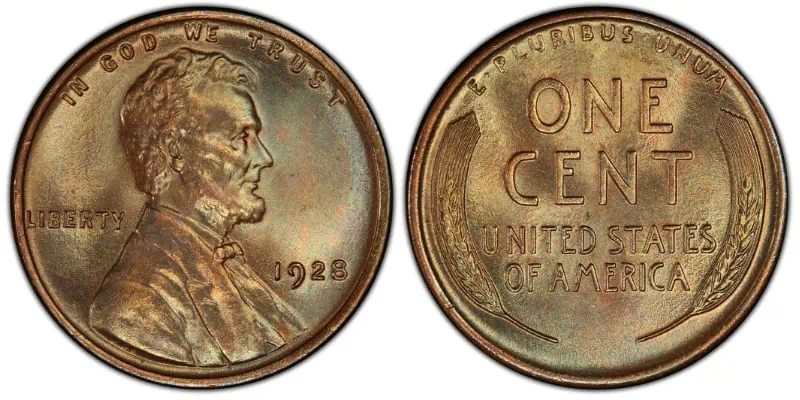
Philadelphia built the first mint after the Coinage Act of 1792 became law on April 2, at Seventh Street and 6331 Filbert Street. The three-story building measured 37 feet by 33 feet, and basement vaults held raw silver and gold while horses turned a rolling mill on the first floor to strike coins.
Floors on the second mint built in 1833 at the intersection of Chestnut and Juniper Streets were thirty times larger, owing to a greatly expanded production schedule and workforce. The third mint building where the 1928 penny was struck opened in 1901, extended nearly a city block at 1700 Spring Garden Street and produced as many as 500 million US coins in a single year.
In 1928, the Philadelphia Mint released 134,116,000 pennies for distribution. Coins were delivered to Federal Reserve Banks and their branch banks as production continued. Bank managers had their first crack at new coins, but the sheer volume rarely led to hoarding of “rare” coins.
However, there have been times when banks haven’t rotated their stock of coins, and specific years or bags of coins have been found after decades of neglect. Many prime condition coins enter the collection field in this way.
No proof coins were produced in 1928 since the US Treasury and the Mint decided there wasn’t high enough demand, and production ceased between 1917 and 1935. However, some amazing mint-state coins still exist.
1928 Penny No Mint Mark Value
Philadelphia 1928 pennies likely to appear in pocket change are brown in color and grade from good to extra fine condition and draw prices of $0.22 to $2.15. Almost uncirculated coins go from $4.05 to $6.75, and Mint State grades from MS60 to MS65 sell from $8.10 to $54.00. Experts agree that coins in all colors are scarce in MS66 and rare in MS67.
Red-brown coins in MS63 to MS66 sell for between $20.25 and $195. Red coins are rarer because oxidation turns the coins red-brown and finally brown, so they command higher prices. You can expect a range of $40.50 to $1,220 for coins in MS63 to MS67.
Choice coins in red are tough to find, but several red MS67 1928 1c coins have sold recently in the $5,000 range. An auction record 1928 Penny no mint mark value of $9,000 was reached in June 2019 for an MS67 red coin through Heritage Auctions.
1928 D Penny
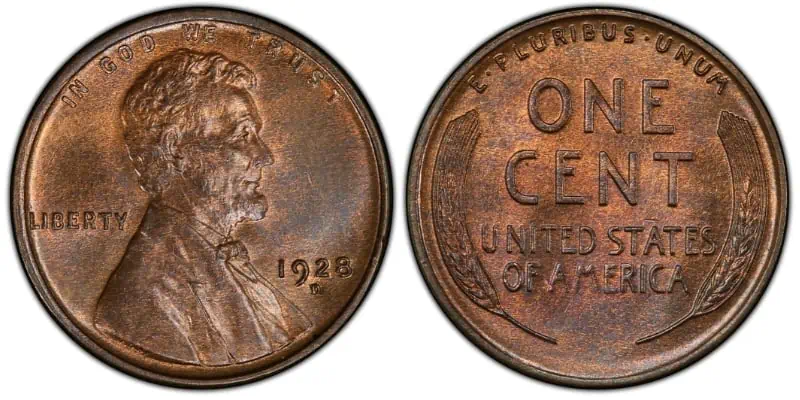
The Denver Mint was built in 1897 at West Colfax Avenue and Delaware Street and began producing US coins in 1906 with the designation of “D” for Denver. The first year the Denver Mint produced Lincoln pennies was 1911 when it struck over 12 million.
In 1928, the mint produced 31,170,000 pennies, about 23 percent as many as the Philadelphia Mint. While there has been talk about the strike being weaker and more pennies seen with wear on the reverse of the 1928 D, this may be true in lower-grade coins but not higher-grade ones.
1928 D Penny Value
The 1928 D penny value in average condition from good to extra fine (brown color) runs from $0.50 to $11.21. In red-brown, grades from MS62 to MS66 average $76 to $1,090.
MS62 to MS67 coins run from $122 to $18,000 in brighter red. Because the Denver Mint struck only about one-quarter as many coins as Philadelphia, one might think their 1928 pennies would be four times as expensive, but they aren’t. Lower-grade coins have a slight premium, and high-grade coins sell at approximately two times the price.
In August 2022, Heritage Auctions sold an MS66 RD for $12,600.
1928 S Penny
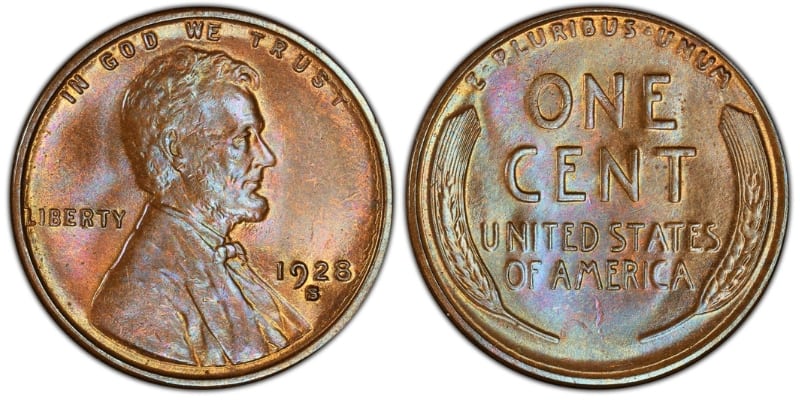
The original United States Mint and Subtreasury was built in 1854 at 608 Commercial Street. The second US Mint, where the 1928 S pennies were struck, began operations in 1874 and survived the 1906 San Francisco earthquake, although the building’s plate glass windows melted in the ensuing fire, and sandstone wall blocks exploded from the heat.
One-third of the US gold reserves were held at the Mint in 1906, worth about $300 million, or $7 billion, adjusted for inflation. None was lost in the earthquake or fire.
For several reasons, the San Francisco “S” mint mark has a unique cache with collectors. Perhaps because of the early gold coins or because the Mint regularly produced an appreciably lower number of coins each year. In the case of Lincoln pennies, it’s possible that collectors instantly loved the coin and the “S” Mint because of the first-issue, highly-valuable S-VDB coin.
As for the 1928-S Lincoln pennies, the Mint struck just 17,266,000, and some numismatists insist the strike is cleaner and more pronounced than the Philadelphia and Denver issues. Others disagree.
1928 S Penny Value
In average condition, from good to extra fine, brown coins sell for $0.55 to $17.55. Mint state coins from MS60 to MS65 sell for $101 to $390—red-brown coins in MS62 to MS 65 command $156 to $1,380.
Bright red 1928-S in MS62 to MS65 condition sell from $585 to $9,250.
Heritage Auctions sold an MS66 RD in April 2020 for $45,600! The coin is truly unique. It has an even-colored reverse with no bag marks or wear, and the obverse sports a reddish hue around Lincoln with a deep strike and perfect rims.
1928 Penny Error
The coinage process at the US Mint is essential to producing high-quality, durable coins. Marc Landry, Philadelphia Mint Superintendent, explains it’s a lengthy, artistic procedure, and over 50,000 dies are made yearly.
In most cases, the dies are changed before errors like die breaks and wear occur. However, errors happen, and they are often scarce. Although some 1928 penny error coins have minor die issues and repunched mint marks, the coins rarely sell for more than $10 to $20 in extra-fine condition. That’s not the case with the “S” mint mark types.
1928 Small and Large “S” Mint Mark
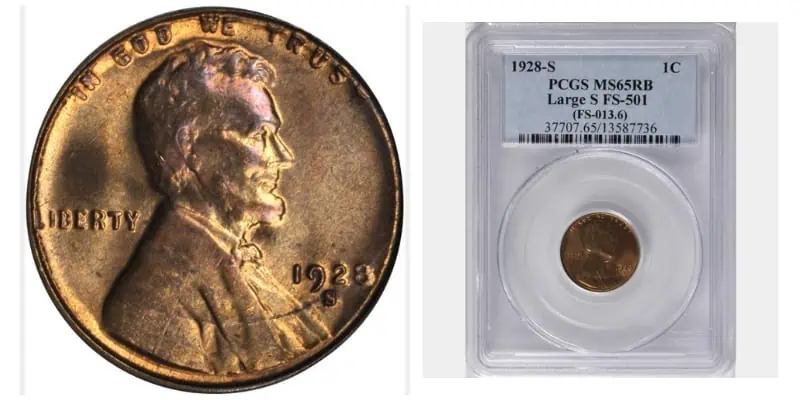
In 1928, the San Francisco Mint experimented with a large “S” on Lincoln pennies. Although variety coins usually fall under a “type” of mintage, in retrospect, it might be considered an error for the Mint to have two sizes for their mint mark in a single year.
Unfortunately, the large mint mark “S” with a thick middle body and bold serif at the top and bottom was minted in an unknown quantity. Although some early literature alluded to the strike styles produced evenly, large “S” coins may be ten times the value of similar small mint mark coins. The large type “S” strike production was likely small.
In brown color, large “S” coins typically sell for a few dollars in good condition; grades of XF45 and higher regularly command prices over $100. Red-brown coins in MS63 and MS64 have auction prices of $223 to $388—an MS65 coin at the Stacks Bowers auction sold in 2017 for $2400.
A red 1928-S 1C Large S, in MS64 condition, sold at auction in 2018 for $1,320.
Final Notes about the 1928 Lincoln Penny
Enough 1928 pennies were struck to allow collectors to obtain all three mint marks in condition at a reasonable price. As with all older and lower production coins, those in mint state will continue to appreciate.
